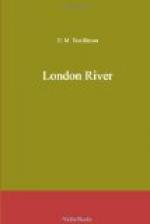The effect of that casual recollection on the submarine officer was distinctly unwarlike. This memory, and not his present work, might have been the real thing. He knew Woodget, the man in the Glengarry. He wanted to know more; ever so much more. He mentioned other ships and masters, to induce me. I got the idea that he would let his mind, at least, escape into that time, if only I would help him to let it go. But there was that potent and silent enigma about us. . . .
No such escape for him. We have fashioned other ships, and must use them. What we have conjured up compels us to live with it. But when you do not go to sea you may have what ships you like. There is some but not much interest in the reappearance in the newspapers of the sailing lists; a few of the old names appear again, though new ships bear them. But late at night, when a westerly wind with rain turns for me a neighbouring yew tree into an invisible surge, then it is the fortune of one who remembers such as the Cutty Sark to choose different ships and other times. Why not choose them? They were comely ships, and now their time seems fair. Who would care to remember the power and grey threat of a modern warship, or the exotic luxury of a liner of this new era? Nobody who remembers the graciousness of the clippers, nor the pride and content of the seamen who worked them. To aid the illusion of the yew, I have one of those books which are not books, a Lloyd’s Register of Shipping for 1880, that by some unknown circuitous route found its way from its first owner in Madras to my suburb. It goes very well with the surge of yew, when westerly weather comes to unite them.
I should like to know how that book got to London. Somewhere in it is the name of the ship which carried it. Anyhow, I think I can make out in it the houseflag of that ship. It, was, I believe, one of J. H. Allan’s teak-built craft, a forgotten line—the Rajah of Cochin, the Copenhagen, the Lincelles,—though only just before the War, in the South-West India Dock, I met a stranger, a seaman looking for work, who regretted its disappearance, and the new company-owned steamers; for he said they were good ships, “but more than that,” he told me, “Allan was an old gentleman who knew his own ships, and knew his men.” This stranger said you forget a ship now as soon as you are paid off, “and glad to,” and “you don’t ever know who owns her, even if there’s a strike. Parsons and old maids and Cardiff sharks, I reckon.”
Very likely. But what sharks once were in it have all disappeared from my Register. It belongs to those days when, if you went to New Zealand, you had to go by sailer; when the East India Dock had an arcade of jib-booms and bowsprits, with sometimes a varnished shark’s tail terminal—the Euterpe, Jessie Readman, Wanganui, Wazmea, Waimate, Opawa, Margaret Galbraith, Helen Denny, Lutterworth, and Hermione. There were others. What is in these names? But how can we tell? There were personal figureheads, there were shapely forms, each with its own narrative of adventure, there was the undiscovered sea, and there was youth; and these have gone.




